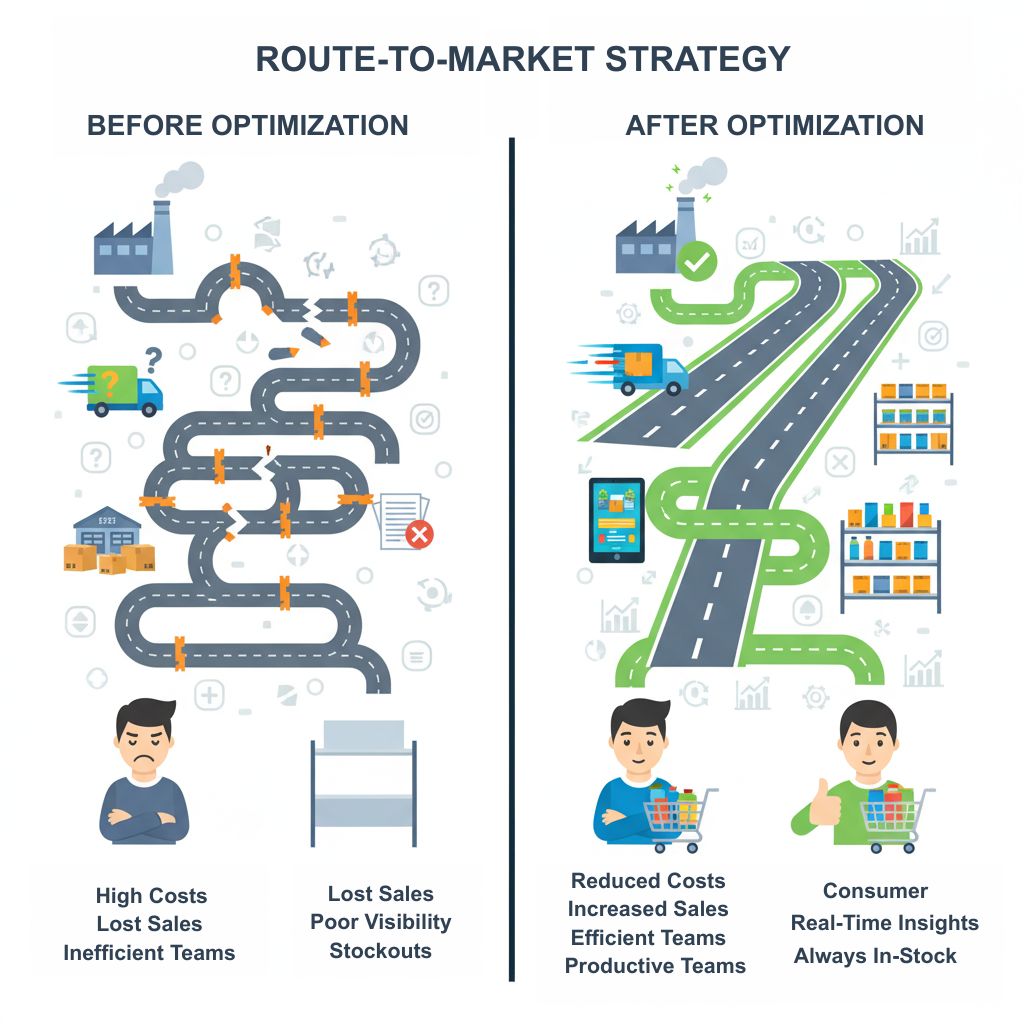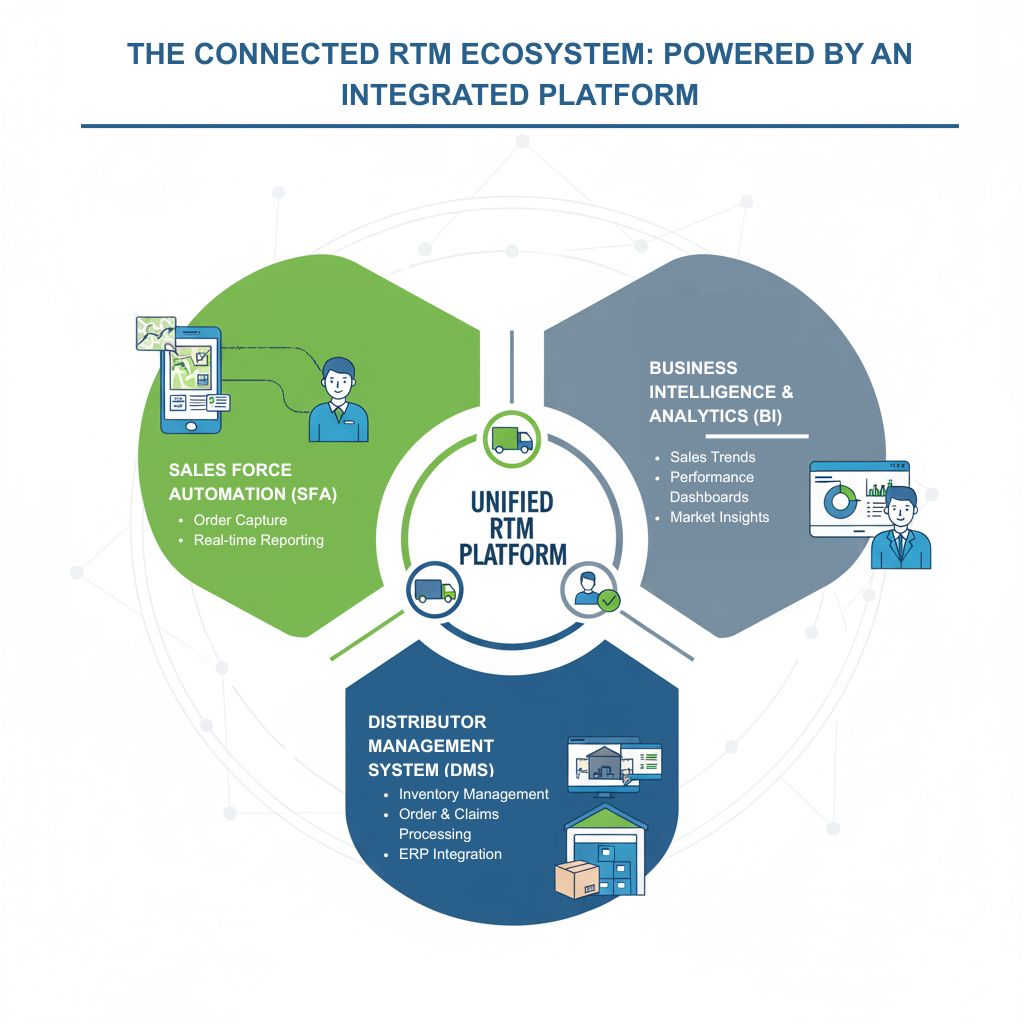The challenge for every FMCG brand is the same: how do you stand out in a sea of similar products and, more importantly, ensure your product is always available to the consumer? The answer lies not in a bigger marketing budget, but in a smarter Route-to-Market (RTM) strategy. A flawed RTM can result in lost sales, damage to the brand reputation, and wasted inventory. Conversely, a well-defined RTM strategy is a powerful asset that drives efficiency, boosts profitability, and guarantees your product’s presence, from urban supermarkets to rural kiosks. This blog will explore the critical role of RTM in the modern FMCG landscape and show you how to build a distribution network that wins.

What is a Route-to-Market (RTM) Strategy in FMCG?
At its simplest, a Route-to-Market strategy is the comprehensive plan a company uses to deliver its products from its production facility to the final consumer. It encompasses every single step in the distribution chain, from the moment a product leaves the warehouse to when it is purchased.
An effective RTM strategy is a complex orchestration of multiple interconnected components:
- Distribution Channels: Deciding whether to sell through wholesalers, distributors, direct-to-retail, e-commerce, or a combination of these channels.
- Logistics & Supply Chain Management: Optimizing warehousing, transportation, and inventory to ensure products are always available without incurring excess costs.
- Sales & Field Force Management: Empowering your on-the-ground sales teams with efficient tools and plans to manage outlets, secure orders, and ensure perfect retail execution.
- Data and Analytics: Leveraging real-time data to gain a panoramic view of market performance, stock levels, and consumer behavior.
In a market as dynamic and fragmented as FMCG, where a single brand might need to reach millions of consumers across thousands of cities and towns, a static, one-size-fits-all approach is a recipe for failure.

The Unmistakable Importance of a Solid RTM Strategy for FMCG Brands
Ignoring the strategic importance of your RTM is like building a state-of-the-art race car and forgetting to lay a proper track. Here’s why it is a fundamental pillar of FMCG success:
- Market Penetration and Reach: A well-designed RTM strategy allows you to penetrate diverse markets, from supermarkets and hypermarkets to the countless small, independent kirana stores that form the backbone of many economies. By segmenting your markets and tailoring your distribution channels, you can ensure your brand has a presence everywhere your target consumer shops.
- Optimized Costs and Increased Profitability: Every operational inefficiency in your distribution chain translates directly to a loss of profit. An optimized RTM strategy can drastically reduce costs related to transportation, warehousing, and inventory holding. By minimizing stock-outs and overstock situations, you avoid lost sales and reduce waste from expired products.
- Enhanced Visibility and Control: In traditional distribution models, the moment a product leaves the warehouse, it enters a “black box” of limited visibility. A modern RTM strategy, enabled by technology, provides end-to-end visibility. You can track everything from a distributor’s stock-in-hand to a sales representative’s daily route. This level of transparency is invaluable for effective FMCG distribution.
- Improved Sales Force Productivity: Your field force is the lifeblood of your RTM. Without the right tools, they spend valuable time on manual tasks. An efficient RTM strategy simplifies these processes, empowering sales reps to spend more time building relationships with retailers and less on administrative work. This direct increase in productivity leads to higher order values and better market coverage.
- Data-Driven Decision Making: The data collected through an optimized RTM system is a goldmine. It provides unparalleled insights into which products are selling where, at what time, and what competitor activities are impacting your sales. This real-time market intelligence allows you to make agile and informed decisions on everything from promotional campaigns to new product launches.
Building a Future-Proof RTM Strategy with Technology

The traditional RTM model, with its reliance on manual, paper-based processes and siloed data, is no longer sufficient. The future of FMCG distribution lies in technology-driven, integrated platforms. This paradigm shift requires a unified ecosystem that connects every stakeholder, from the manufacturer to the distributor, and the sales team to the retailer.
An intelligent, connected distribution platform becomes essential here. Such a platform acts as a dedicated assistant for your entire distribution ecosystem, orchestrating complex processes with precision and clarity. It’s a unified solution that streamlines operations and empowers teams.
Think of it as a central nervous system for your distribution. It provides:
- Sales Force Automation (SFA): Equipping your field force with mobile apps to capture orders, track beat plans, and report market intelligence in real-time. A modern SFA solution, like MAssist, can offer features such as geo-fencing for attendance, automated route mapping, and real-time order processing to drastically cut down on administrative burden and boost productivity.
- Distributor Management System (DMS): Providing a seamless, automated link with your distributors to manage inventory, sales, and claims. A sophisticated DMS, such as one from MAssist, ensures two-way visibility of inventory and sales, while also automating processes like order management and claims. It integrates with your ERP to create a single source of truth, eliminating discrepancies and improving collaboration.
- Business Intelligence & Analytics: Transforming raw data into intuitive dashboards and reports, giving leaders a clear, actionable view of performance across every channel and territory. A robust BI module, which is a core part of the MAssist platform, can generate dynamic reports on sales trends, outlet performance, and competitor activities, all in real-time. This is where data moves from being a historical record to a predictive tool.
By leveraging an integrated platform, companies can move beyond guesswork and manual fixes. They can implement a style of efficiency where automated systems handle routine tasks and provide proactive alerts, freeing up human talent to focus on strategic growth and relationship-building.
Conclusion: It’s Time to Optimize Your FMCG Route-to-Market
In the ever-evolving FMCG landscape, a great product is just the beginning. The real winners are those who master the art and science of their Route-to-Market strategy. By embracing modern, technology-driven solutions, you can transform your distribution from a cost center into a powerful engine for growth.
Investing in a comprehensive RTM strategy means investing in efficiency, visibility, and scalability. It allows you to not only meet but exceed the demands of a competitive market, ensuring your brand is always on the shelf, ready for the consumer. It’s time to stop thinking of RTM as a back-end function and start seeing it for what it truly is: the key to unlocking sustainable, long-term FMCG success.
Frequently Asked Questions (FAQs) about Route-to-Market Strategies
Q1: What is the primary goal of a Route-to-Market strategy in the FMCG sector?
Answer: The primary goal is to ensure your products efficiently and profitably reach the end consumer through the optimal combination of distribution channels, logistics, and sales processes.
Q2: How does technology improve RTM strategies?
Answer: Technology, such as a platform like MAssist, improves RTM by providing real-time data on sales, inventory, and field activities. This enhances visibility, automates manual tasks, reduces costs, and enables data-driven decision-making.
Q3: What are the biggest challenges in FMCG distribution?
Answer: Common challenges include managing a fragmented network of distributors and retailers, ensuring product availability to prevent stock-outs, and a lack of real-time visibility into market performance and sales activities.
Q4: How can a platform like MAssist help my FMCG business?
Answer: MAssist streamlines your entire RTM process by integrating Sales Force Automation (SFA), a Distributor Management System (DMS), and powerful Business Intelligence (BI) into a single platform. This helps you boost sales, increase efficiency, and gain critical market insights.
